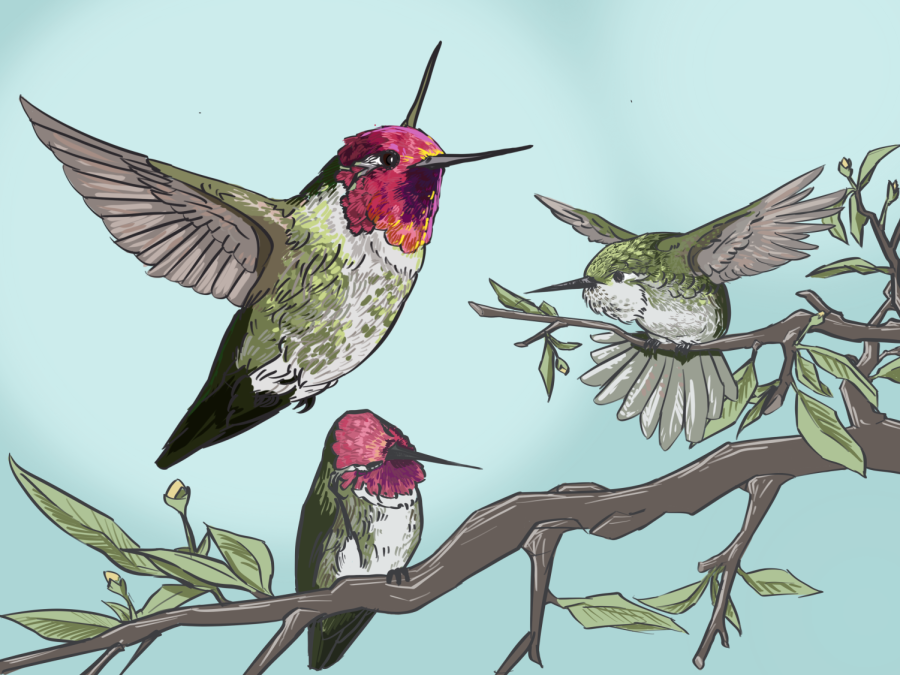Find a feathered friend: The Anna’s hummingbird
Although they often go unnoticed, the Anna’s hummingbird is here on campus all the time. They frequent the red flowers in the orchard; they enjoy the company of the sage bushes in the quad; they sing their animated song in the trees near the Zhang Athletic Center.
February 6, 2023
Believe it or not, there are wild fighter jets on campus. You can catch a glimpse of the green blurs as they zoom around the orchard and the quad, parking on trees by Manzanita Hall and the front loading zone. People who amble too close risk facing the wrath of consecutive yet unpredictable divebomb attacks amidst the loud whirring of their “engines.” No matter where, there’s bound to be at least one — a hummingbird.
You’ve probably seen a couple of them as you walk around campus, but it’s more likely you’ve heard these frisky friends as they engage in a territorial game of tag while screaming like broken jacket zippers.
But you might not know that the buzzing and chirping song of the local Anna’s hummingbird (scientific name Calypte anna) is actually quite special. No hummer can mimic a songbird or warbler’s elaborate melodies, but these feathered friends are known to be more vocal than other hummingbird species, singing for an astounding 10 seconds or more (Hear their call!). Male Anna’s will use this song to woo female hummingbirds during breeding season, which occurs between early winter and early summer.
However, the Anna’s hummingbird is not only meant to be heard but also seen. Like many other organisms, the Anna’s hummingbird is sexually dimorphic, meaning the males are more colorful to help them court their female counterparts.
A male Anna’s hummingbird has a distinguishable magenta colored crown and gorget, the cap and the chin area of a hummingbird’s head respectively, that resemble a shiny pink ruby (See a male Anna’s hummingbird’s snazzy display). Their bright colors play a key role in the Anna’s hummingbird mating ritual, where the male hummingbirds attempt to impress the females by flashing their bright colors.
In comparison, the females lack most of the colorful feathers found on a male’s head, although some females have gorgets as well. Birdwatchers beware, though! Since they have yet to fully grow their flirty feathers, juvenile male hummingbirds often resemble adult females, but their general coloring tends to be more vibrant.
Although they often go unnoticed, the Anna’s hummingbird is here on campus all the time. They frequent the red flowers in the orchard; they enjoy the company of the sage bushes in the quad; they sing their animated song in the trees near the Zhang Athletic Center.
What’s more, according to the American Bird Conservancy, the Anna’s hummingbird was named after a 19th century Italian duchess known as Anna Masséna — that is to say, the history of this hummingbird’s discovery is at least 50 years older than the history of the school it lives in. So when you hear the hummingbird’s call, or see a bout of avian warfare in the quad, you’re in the presence of the legacy of Italian royalty.


















![“[Building nerf blasters] became this outlet of creativity for me that hasn't been matched by anything else. The process [of] making a build complete to your desire is such a painstakingly difficult process, but I've had to learn from [the skills needed from] soldering to proper painting. There's so many different options for everything, if you think about it, it exists. The best part is [that] if it doesn't exist, you can build it yourself," Ishaan Parate said.](https://harkeraquila.com/wp-content/uploads/2022/08/DSC_8149-900x604.jpg)




![“When I came into high school, I was ready to be a follower. But DECA was a game changer for me. It helped me overcome my fear of public speaking, and it's played such a major role in who I've become today. To be able to successfully lead a chapter of 150 students, an officer team and be one of the upperclassmen I once really admired is something I'm [really] proud of,” Anvitha Tummala ('21) said.](https://harkeraquila.com/wp-content/uploads/2021/07/Screen-Shot-2021-07-25-at-9.50.05-AM-900x594.png)







![“I think getting up in the morning and having a sense of purpose [is exciting]. I think without a certain amount of drive, life is kind of obsolete and mundane, and I think having that every single day is what makes each day unique and kind of makes life exciting,” Neymika Jain (12) said.](https://harkeraquila.com/wp-content/uploads/2017/06/Screen-Shot-2017-06-03-at-4.54.16-PM.png)








![“My slogan is ‘slow feet, don’t eat, and I’m hungry.’ You need to run fast to get where you are–you aren't going to get those championships if you aren't fast,” Angel Cervantes (12) said. “I want to do well in school on my tests and in track and win championships for my team. I live by that, [and] I can do that anywhere: in the classroom or on the field.”](https://harkeraquila.com/wp-content/uploads/2018/06/DSC5146-900x601.jpg)
![“[Volleyball has] taught me how to fall correctly, and another thing it taught is that you don’t have to be the best at something to be good at it. If you just hit the ball in a smart way, then it still scores points and you’re good at it. You could be a background player and still make a much bigger impact on the team than you would think,” Anya Gert (’20) said.](https://harkeraquila.com/wp-content/uploads/2020/06/AnnaGert_JinTuan_HoHPhotoEdited-600x900.jpeg)

![“I'm not nearly there yet, but [my confidence has] definitely been getting better since I was pretty shy and timid coming into Harker my freshman year. I know that there's a lot of people that are really confident in what they do, and I really admire them. Everyone's so driven and that has really pushed me to kind of try to find my own place in high school and be more confident,” Alyssa Huang (’20) said.](https://harkeraquila.com/wp-content/uploads/2020/06/AlyssaHuang_EmilyChen_HoHPhoto-900x749.jpeg)











